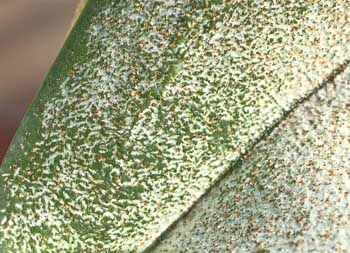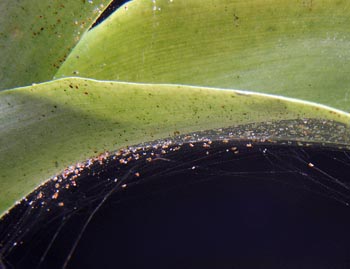|
Welcome to the AOS Beginner's Newsletter. We will be sending you monthly tips on how to grow orchids and help you get them to bloom again. In addition to the information presented here, we invite you to visit the AOS website at www.aos.org and check out the information found under ORCHID INFORMATION > ORCHID BASICS.
Small Bug Can Cause Mitey Big Problems

Like the thrips we mentioned last month, mites have stealth as their advantage. Unless you have really good eyesight and a strong magnifying lens, you may never even see a spider mite. Usually, the first thing that will alert you to a spider mite epidemic is the silvery stippling on the underside of orchid leaves. That is, if you happen to be in the habit of looking underneath your orchid leaves. If you are not, you may not notice until the damage has spread to the upper surfaces. If you have a 10x or 20x magnifer you can confirm the presence of mites by looking at a suspected leaf. You will see the small eight-legged critters scurrying about. Another way to determine their presence is to wipe the leaf with a white tissue or paper towel. If there are mites, there will be a red-brown smear on the tissue. If you don't notice a spider mite outbreak until you see silk webs on the undersides of leaves you have probably already sustained significant damage. The word to the wise is observation.
Most information you read will tell you that spider mite outbreaks are more likely to be seen when weather conditions are hot and dry. Then they will go on to tell you to increase humidity as a means of prevention. This advice may work well for growers in northern temperate zones and it is certainly the most benign means of preventing mites. In places like the Gulf Coast and South Florida, humidity rarely goes below 70% in the summer and spider mites can still be a problem. Diligence is the best prophylactic against all pests. It is a lot easier to eliminate a few mites on a Phalaenopsis than it is to control a runaway outbreak on a seedling bench!

Most of the household remedies mentioned in the past two newsletters will also provide control on minor mite problems. Using a solution of soapy water to thoroughly wash the leaves of a mite-infected orchid may be all it takes to solve the problem. Rinse with clear water afterwards and keep the plant isolated for a week or two to be sure you have eliminated the pests. Isopropyl rubbing alcohol in a quart hand sprayer can be used to "jet away" mites from the underside of orchid leaves. Insecticidal soaps, horticultural oils and especially Neem Oil can be effective against mites.
Biological controls such as green lacewing larvae and predatory mites can be effective controls in a closed greenhouse. Just remember that a commitment to biological controls has to be 100%. You cannot spray any agricultural chemicals without killing off beneficial insects along with the bad guys.

Because mites are eight-legged creatures more closely related to spiders, regular insecticides do not work to kill them. For serious mite control, special chemicals called miticides are called for. For many years, Kelthane was the orchid hobbyist's miticide of choice. It is no longer registered for orchid use and is now sold only to professionals. Newer chemicals such as Avid or Pentac will effect control of mites as will growth regulators based on Azadirachtin, which may be safer for humans. Sprays based on Pyrethrins are said to also be effective against mites. Before using any pesticides, read and follow label instructions explicitly.
Experienced orchid growers will identify and treat a problem before strong agricultural chemicals are needed. Make sure that you are one of them!
Greg Allikas
October 2010
| 
